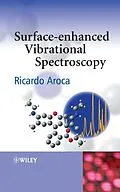Surface Enhanced Vibrational Spectroscopy (SEVS) has reachedmaturity as an analytical technique, but until now there has beenno single work that describes the theory and experiments of SEVS.This book combines the two important techniques of surface-enhancedRaman scattering (SERS) and surface-enhanced infrared (SEIR) intoone text that serves as the definitive resource on SEVS.
* Discusses both the theory and the applications of SEVS andprovides an up-to-date study of the state of the art
* Offers interpretations of SEVS spectra for practicinganalysts
* Discusses interpretation of SEVS spectra, which can often bevery different to the non-enhanced spectrum - aids the practicinganalyst
Autorentext
Professor Ricardo Aroca is based in the School of Physical Sciences, University of Windsor, Canada. He has almost 250 publications and his research interest are i) single molecule detection, ii) nanostructures for surface-enhanced spectroscopy and iii) in hydrogen storage materials.
Klappentext
This book discusses two of the many enhanced optical phenomena in surface-enhanced spectroscopy: surface-enhanced Raman scattering (SERS) and surface-enhanced infrared absorption (SEIRA). Together, these form a new branch of vibrational spectroscopy Surface-Enhanced Vibrational Spectroscopy (SEVS). SEVS deals with the enhanced spectra of molecules on specially fabricated metal nanostructures with the ability to support surface plasmons and to enhance optical signals. The great advantage of vibrational spectroscopy is that it provides the fingerprint of any molecular system; with a large amount of vibrational assignment data for gas, liquid, solid, and, most relevant to SEVS, surface complex systems widely available in the literature. SEVS is an extremely powerful addition to surface-sensitive and single molecule spectroscopies (SMS).
The book begins with a review of the vibrating molecule and the origin of infrared and Raman spectra.
Chapter 2 contains brief discussions on the absorption and scattering of light by metallic nanoparticles, the fabrication of nanostructures, and the selection of the appropriate experimental conditions for SERS and SEIRA.
Chapter 3 is dedicated to SERS as a surface plasmon assisted spectroscopy and includes discussion of the most rudimentary models that provide guidance for the experimentalist.
Chapter 4 examines the role in observed SERS spectra of moleculenanostructure interactions, or chemical effects.
Chapter 5 is dedicated to demonstrating that the SERS effect is functional for all molecular types.
Chapter 6 presents an overview of SERS applications.
The concluding chapter describes surface-enhanced infrared absorption (SEIRA) and its applications.
Each chapter contains extensive citation to help the user, and to make the book a useful reference. A glossary is also included to help provide common terminology for those working in the multiple disciplines touched by SERS (chemistry, solid state physics, optics and electrodynamics). A comprehensive reference database of almost 3000 references from the literature from 1980 to 2004 with a listing of references by keyword is provided on www.spectroscopynow.com
The book is intended to serve as an introduction for scientists, technologists, and students who may use some aspect of surface-enhanced vibrational spectroscopy in their work. It has been designed to provide a general introduction to concepts and techniques, rather than a strong theoretical or experimental background. Given the multidisciplinary nature of the phenomenon and its applications, the book will be a practical help for anyone in chemistry, physics, biomedical research, or materials science in need of ultrasensitive chemical analysis with high information content, and high spatial resolution.
Inhalt
Preface.
Acknowledgments.
Glossary.
1. Theory of Molecular Vibrations. The Origin of Infrared andRaman Spectra.
1.1 Electronic, Vibrational, Rotational and TranslationalEnergy.
1.2 Separation of Nuclear and Electronic Motions.
1.3 Vibrations in Polyatomic Molecules.
1.4 Equilibrium Properties. Dipole Moment andPolarizability.
1.5 Fundamental Vibrational Transitions in the Infrared andRaman Regions.
1.6 Symmetry of Normal Modes and Vibrational States.
1.7 Selection Rules.
1.8 The Example of ab initio Computation of the Raman andInfrared Spectra.
1.9 Vibrational Intensities.
1.10 Definition of Cross-Section.
1.11 The Units of Energy and Force Constants.
References.
2. The Interaction of Light with Nanoscopic Metal Particlesand Molecules on Smooth Reflecting Surfaces.
2.1 Electric Permittivity and Refractive Index.
2.2 Propagation of Electromagnetic Waves and the OpticalProperties of Materials.
2.3 Scattering and Absorption by Nanoscopic Particles.
2.4 Reflection-Absorption Infrared Spectroscopy on SmoothMetal Surfaces.
References.
3. Surface-Enhanced Raman Scattering (SERS).
3.1 Electromagnetic Enhancement Mechanism.
References.
4. Chemical Effects and the SERS Spectrum.
4.1 Physical and Chemical Adsorption.
4.2 SERS/SERRS of Physically Adsorbed Molecules.
4.3 SERS of Chemically Adsorbed Molecules without ElectronicResonance Excitation.
4.4 SERS of Chemically Adsorbed Molecules with Charge TransferExcitation.
4.5 Metal-Molecule or Molecule-Metal ChargeTransfer.
4.6 SERRS from a Surface Complex.
References.
5. Is SERS Molecule Specific?
References.
6. SERS/SERRS, the Analytical Tool.
6.1 Average SERS on Metal Colloids. Preparation andProperties.
6.2 Metal Colloids. The Background SERS.
6.3 Metal Colloids. Maximizing the Average SERS in Solution.
6.4 Average SERS on Metal Island Films.
6.5 Average SERS on Rough Electrodes.
6.6 Ultrasensitive SERS Analysis and Single MoleculeDetection.
6.7 Uniqueness of Ultrasensitive Chemical Analysis. The MovingTarget.
6.8 Applications and Outlook.
References.
7. Surface-Enhanced Infrared Spectroscopy.
7.1 Overview.
7.2 Theoretical Models for SEIRA.
7.3 SEIRA-Active Substrates.
7.4 Interpretation of the Observed SEIRA Spectra.
7.5 Applications of SEIRA.
References.
Index.
